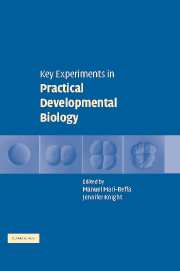Book contents
- Frontmatter
- Contents
- List of contributors
- Preface
- Introduction
- SECTION I GRAFTINGS
- SECTION II SPECIFIC CHEMICAL REAGENTS
- SECTION III BEAD IMPLANTATION
- SECTION IV NUCLEIC ACID INJECTIONS
- SECTION V GENETIC ANALYSIS
- SECTION VI CLONAL ANALYSIS
- 14 The role of the gene apterous in the development of the Drosophila wing
- 15 Extramacrochaetae, an example of a gene required for control of limb size and cell differentiation during wing morphogenesis in Drosophila
- 16 Hedgehog transduction pathway is involved in pattern formation in Drosophila melanogaster tergites
- SECTION VII IN SITU HYBRIDIZATION
- SECTION VIII TRANSGENIC ORGANISMS
- SECTION IX VERTEBRATE CLONING
- SECTION X CELL CULTURE
- SECTION XI EVO–DEVO STUDIES
- SECTION XII COMPUTATIONAL MODELLING
- Appendix 1 Abbreviations
- Appendix 2 Suppliers
- Index
- Plate Section
- References
14 - The role of the gene apterous in the development of the Drosophila wing
Published online by Cambridge University Press: 11 August 2009
- Frontmatter
- Contents
- List of contributors
- Preface
- Introduction
- SECTION I GRAFTINGS
- SECTION II SPECIFIC CHEMICAL REAGENTS
- SECTION III BEAD IMPLANTATION
- SECTION IV NUCLEIC ACID INJECTIONS
- SECTION V GENETIC ANALYSIS
- SECTION VI CLONAL ANALYSIS
- 14 The role of the gene apterous in the development of the Drosophila wing
- 15 Extramacrochaetae, an example of a gene required for control of limb size and cell differentiation during wing morphogenesis in Drosophila
- 16 Hedgehog transduction pathway is involved in pattern formation in Drosophila melanogaster tergites
- SECTION VII IN SITU HYBRIDIZATION
- SECTION VIII TRANSGENIC ORGANISMS
- SECTION IX VERTEBRATE CLONING
- SECTION X CELL CULTURE
- SECTION XI EVO–DEVO STUDIES
- SECTION XII COMPUTATIONAL MODELLING
- Appendix 1 Abbreviations
- Appendix 2 Suppliers
- Index
- Plate Section
- References
Summary
OBJECTIVE OF THE EXPERIMENT The objective of the experiment detailed below is to study the function of the Drosophila gene apterous (ap) in the development of the wing in clones of mutant cells (Díaz-Benjumea and Cohen, 1993). The analysis of this experiment is a way to introduce the concept of an organizer center in development.
DEGREE OF DIFFICULTY Moderate. The experiments require some experience in the handling of flies and in the preparation of microscope slides with fly wings. The original technique of mitotic recombination clones requires the availability of an X-ray source, which is the greatest restriction for this exercise.
INTRODUCTION
Vertebrate and invertebrate appendages have been used as model systems to study the mechanisms that underlie pattern formation in multicellular organisms. Experimental embryologists addressed these studies by microsurgical analysis (grafting, cauterization, etc.). Drosophila offers the advantage of a genetic system in which to decipher the roles of specific genes. Many genes have been identified and characterized that are involved in patterning Drosophila appendages. One of the most striking discoveries was the identification of “developmental compartments” (García-Bellido et al., 1973). Compartments were first identified in Drosophila as developmental restrictions detected by cell lineage analysis. These restrictions subdivide the wing into four different compartments: anterior (A), posterior (P), dorsal (D) and ventral (V) (Figure 14.1). The A/P restriction is established during early embryonic development and the D/V restriction is established during larval development (60 hours after egg laying (AEL)).
- Type
- Chapter
- Information
- Key Experiments in Practical Developmental Biology , pp. 167 - 177Publisher: Cambridge University PressPrint publication year: 2005



